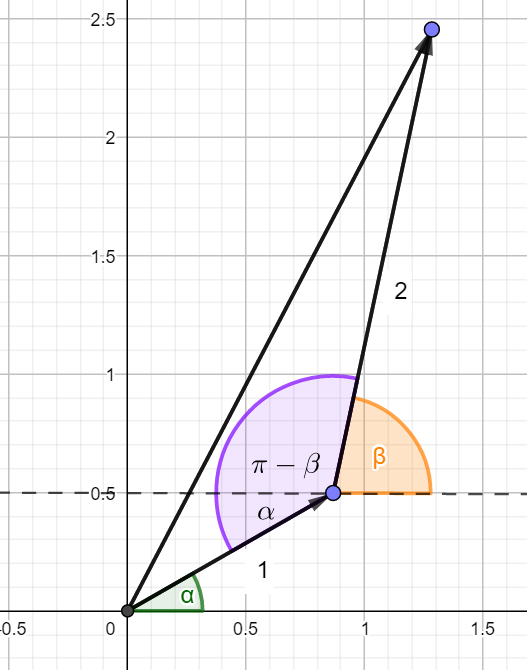Thanks Alan,
I also got 343 but i think my method was a bit unconventional and I wan't sure about the power of 6 bit.
This is how I did it.
(the angles in the pic are not to scale)
\(\beta = \frac{10\pi}{21},\qquad \alpha = \frac{\pi}{7}\)
To find the length of the resultant vector I used the cosine rule.
\(length^2=1^2+2^2-2*1*2*cos(\pi-\beta +\alpha)\\ length^2=5-4cos(\pi-(\beta -\alpha))\\ length^2=5+4cos(\beta -\alpha)\\ length^2=5+4cos(\frac{10\pi}{21} -\frac{3\pi}{21})\\ length^2=5+4cos(\frac{\pi}{3})\\ length^2=5+4cos(\frac{\pi}{3})\\ length^2=5+2\\ length^2=7\\ length^6=343\\ \text{So I think this means that } |(z+w)|^6=343\\ ~\\ \text{But I am asked for }|(z+w)^6| \\ \text{Alan gave the same answer, are they always the same??}\\\)
Could you comment please Alan?

LaTex:
length^2=1^2+2^2-2*1*2*cos(\pi-\beta +\alpha)\\
length^2=5-4cos(\pi-(\beta -\alpha))\\
length^2=5+4cos(\beta -\alpha)\\
length^2=5+4cos(\frac{10\pi}{21} -\frac{3\pi}{21})\\
length^2=5+4cos(\frac{\pi}{3})\\
length^2=5+4cos(\frac{\pi}{3})\\
length^2=5+2\\
length^2=7\\
length^6=343\\
\text{So I think this means that } |(z+w)|^6=343\\
~\\
\text{But I am asked for }|(z+w)^6| \\
\text{Alan gave the same answer, are they always the same??}\\